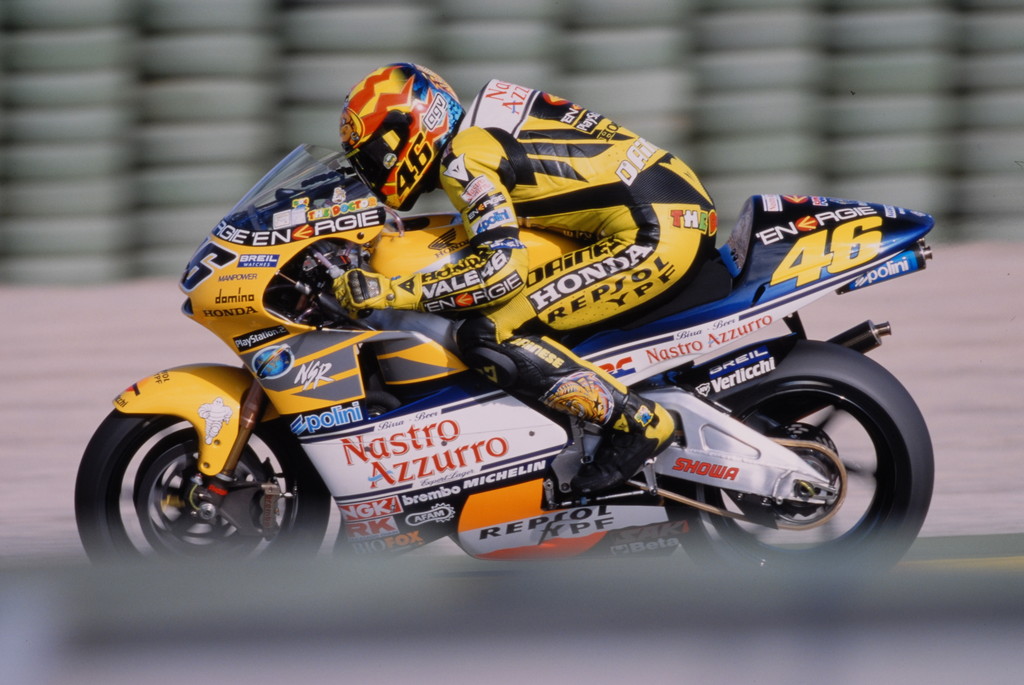2001, the last year of the legendary two-stroke 500 class. Vale's second year in the World Championship’s premier category. That year, Valentino Rossi’s leather suit was perhaps one of the most iconic and unforgettable ones – totally yellow, just like the motorcycle, strongly conveying the feeling of belonging to an independent team that allowed riders to freely choose their own colors. And then, a different nickname printed on the lower back: 2001 was his first year as “The Doctor”, a nickname that replaced the previous “Valentinik”.
The features of the suit worn by Valentino during the 2001 season are, by today’s standards, those of a conventional kangaroo leather suit. At the time, it embodied the highest technology available for motorcycle protection. Riders’ racing suits, as well as top-end production models, were made of kangaroo leather, rather than the more common cow leather. The peculiarity of kangaroo leather is that it offers equal levels of resistance and protection even at a lower thickness, and is therefore lighter and stretchier, allowing for greater freedom of movement.
As in most racing suits, the leather construction is perforated at strategic points, for optimal air flow and heat exchange without compromising its resistance in the event of a fall.

Valentino Rossi's 2001 leather suit was built around rigid protectors, integrated on knees, shoulders and elbows. This type of protector has revolutionized the safety of motorcycle riders from as early as the 1970s – up to then, double layers of leather, or some foam padding at most, were simply placed on the most exposed areas. At the start of the millennium, the D-air® electronic airbag system that would revolutionize motorcycle racing protection only a few years later was still being developed.
Back humps, introduced in the late 1980s to complement the protection provided by back protectors, were also used. In fact, in order not to be harmful in the event of hyperextension of the neck, they couldn’t extend to the lower cervical vertebrae. This is why additional protection was introduced, to protect where back protectors couldn’t.
The first professional riders to use the hump, however, realized that it also made them more aerodynamic, reducing turbulence in the helmet area. It was therefore also developed along these lines, and in a short time it acquired the elongated shape it still has today.
Cutting-edge sliders, introduced in the early 1990s after about ten years’ development, feature on the knees, on the outside. In the back area, the stretch leather panel is visible, while a stretch high-abrasion-resistance fabric covers the inner arms and back of the knees. These are characteristics aimed at improving comfort while riding and increasing freedom of movement, so as to enhance performance and safety.
A trait that distinguishes Dainese suits from all other suits is their design, which allows for IN boots to be accommodated. Introduced in 1998, boots to be worn inside the suit revolutionized the way foot protection was conceived. Even more so in 2001, when the Axial boots came on the scene – unique footwear distinguished by its inner structure in hyper-resistant carbon fiber, protecting against impacts and preventing unnatural twists or stretches of the ankle.
As we said above, 2001 was Valentino Rossi's second year in the premier class. His ‘probationary period’ was over, as the legendary victories he gained illustrate. He totally dominated the season, gaining 11 wins in 16 races, a withdrawal – at home, at the Mugello Grand Prix – and only three placings off the podium.
An unstoppable winning streak that also led Vale to win the championship at Phillip Island, with two races to spare, and finish it over 100 points ahead of runner-up Max Biaggi. Having triumphed in the 125 class in 1999 and in the 250 class in 1997, in 2001 Valentino conquered a third category with his third World Championship Title. Due to the 2001 World Championship, Valentino will forever be the last winner of the 500 class.